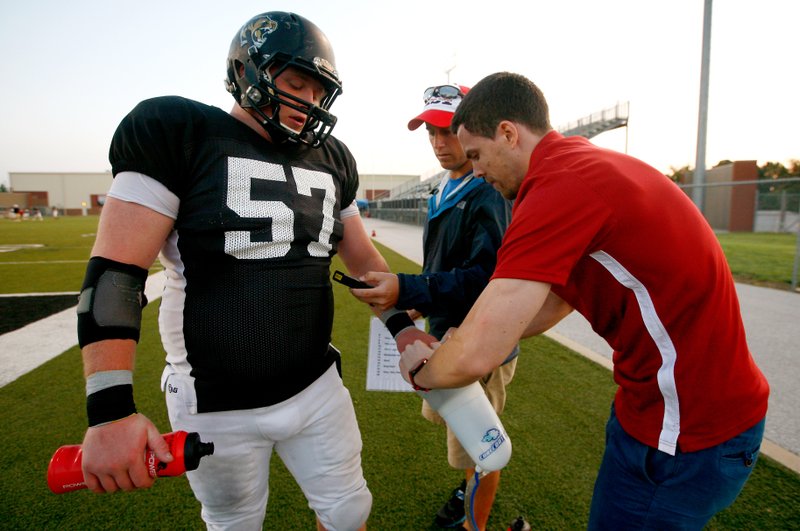BENTONVILLE - Robert Huggins has spent this week suiting up high school football players in Northwest Arkansas with a body-cooling device and GPS monitors as part of his doctoral dissertation on athletic hydration safety and performance.
Huggins, a fourth-yeardoctoral student at the University of Connecticut, joined research colleagues from there and from the University of Arkansas at Fayetteville in a field test of the cooling device during preseason practice, using volunteers from Bentonville High School and Rogers High School.
“They’re the only two in the country doing this now,”Huggins said as the Bentonville players began winding up their practice Thursday morning at Tiger Stadium.
Researchers like Huggins and UA’s Brendon McDermott study ways to keep athletes, soldiers and others who must work in hot or humid conditions wearing heavy equipment safe from heatstroke and other heat-related illness. This includes proper hydration and thermal physiology.
McDermott, an assistant professor of kinesiology at UA who is involved with the body-cooling research, said the two study areas are “closely tied,” adding that three Fayetteville campus researchers also are studying these areas.
The research projectin Arkansas this week involves 30 test subjects, with 15 wearing a cooling pod known as CoreControl on their hands during breaks in practice. The other 15 constitute the study’s control group, meaning they don’t wear a cooling glove. All test subjects are asked to hydrate as they normally do during practice.
According to the permission letter given to the players and parents, the subjects also were asked to wear GPS monitoring devices under their football pads to record heart rate, distance and speed. Additionally, the participants were asked to ingest an FDA-approved “temperature pill” the night before practice that allows a reading of core temperatures during practice.
The pill, manufactured by HQ of Palmetto, Fla., is a medical device that has been used by the military and professional sports teams, Huggins said. A magnet is removed before it is swallowed.
“That turns the pill on,” he said.
The pill doesn’t dissolve and passes through the body, usually in 24 hours, said Huggins, who is also director of athletic testing and performance at the Korey Stringer Institute, based at the University of Connecticut.
BODY-COOLING GLOVE
The Stringer Institute was founded after the August 2001 death of Minnesota Vikings offensive lineman Korey Stringer. His death was attributed to exertional heatstroke after a preseason practice and has been cited by researchers and health advocates as a key trigger for increased awareness about heat illnesses.
Lab studies have shown the CoreControl hand-cooling device to be safe and effective, but those studies involved heat chambers and controlled conditions - not real life, McDermott said. The device is made by Ohio-based Dynavision International.
“This is the first field study, to my knowledge,” McDermott said as he stood at the edge of Tiger Stadium’s artificial turf, which was dotted with mounds of crushed ice that had been emptied from the glove devices’ cooling chambers.
Taylor Hixson, a product specialist with Dynavision, said the trademarked Core-Control Cooling Glove is a nonmedical device designed “to cool a healthy person who has an increased temperature due to exertional activity.” A person slips one hand into the glove, which has a “water profusion” pad that is filled with water cooled to 61.5 degrees Fahrenheit.
The glove was developed at Stanford University, said Hixson, a former athlete who did her undergraduate work in athletic training.
According to the company’s website, humans have “radiator” surfaces on the body, including the palm of the hand and soles of the feet, where the body dissipates heat from its core. The CoreControl glove uses the cool water and a slight vacuum effect to amplify the heat dissipation.
Heat raises the body’s core temperature and induces loss of water through perspiration. Humidity lowers the body’s ability to dissipate heat, as it reduces the ability of sweat to evaporate, which cools the body, Mc-Dermott said.
But while the risk of heat illnesses rises with heat and humidity, McDermott noted: “I have seen exertional heatstroke with temperatures in the 40s.”
Huggins and the other researchers expected to encounter a typical hot, humid August in Arkansas. But Thursday morning’s practice in Bentonville took place with temperatures in the high 50s and lower 60s, while Rogers’ afternoon practice had 75-degree temperatures.
Ultimately, the researchers said, data from a range of temperatures will come in handy.
HEAT-ILLNESS PREVENTION
In Arkansas, a state law signed in May 2011 requires all coaches of Arkansas Activities Association member schools to receive training on heat illness every three years. In June 2011, the association’s 19-member board also approved several guidelines regarding preseason football practice, including limiting the maximum length of one practice to three hours and having at least one hour of rest and recovery between practices.
Thursday morning inthe Bentonville stadium, as senior Zach Brunetti was talking about his participation in the hand-cooling research, he noted the gleeful screams of his fellow players, who were soaking in 60-degree cooling tubs beneath the bleachers.
“We’re always hydrated,” said Brunetti, 17, who was part of the study’s control group. He also pointed out a hand-built misting tent on the far side of the stadium and mobile hydration stations featuring water tanks and spigots on wheels.
Jeff McGee, Bentonville’s head athletic trainer, said he improved on the high school’s hydration arsenal and pushed for written policies when he arrived four years ago, but he credited the financial and moral support of the parent booster club and School Board with making it happen.
Various electronics monitor everything from humidity and wind speed to turf temperature, which can register much higher than ambient air temperature. Practices are moved inside when needed, or extra water breaks are added.
“Every football player is required after practice to get into hydration status,” Mc-Gee said, and that includes 12 minutes in the tub. “It’s like a cold whirlpool.”
Northwest Arkansas, Pages 9 on 08/16/2013

